|
October 2015 - December 2015 |
| |
|
|
 |
|
 |
| |
Publisher: Chairman Gong-Ru Lin Editors: Professor
Chao-Hsin Wu, Ms. Hsiao-wen Lin February 29, 2016 |
| |
|
 |
|
Congratulations to GIPO
professor Gong-Ru Lin! A collaborative
paper authored by Professor Lin and
other international scholars has been
quoted and was the subject of a focused
report by Nature Photonics.
For
further information, please refer to the
following GIPO website: http://gipo.ntu.edu.tw/p5news-detail.php?sn=8647
Congratulations to the following graduate students on being awarded, under the instruction of Professor Chi-Kuang Sun and Professor Gong-Ru Lin, the “2015 Youth Theses Prize of the Chinese Institute of Electrical Engineering”. The winners’ list is as follows:
The 1st place:
|
Winner |
Adviser |
Thesis title |
|
Chung-Yu Lin (Master student) |
Professor Gong-Ru Lin |
Directly Modulated Dual-wavelength Laser Carrier Based MMWoF Wireless Communication Network |
The 3rd place:
|
Winner |
Adviser |
Thesis title |
|
Szu-Yu Lee
(Master student)
|
Professor Chi-Kuang Sun |
Realization and Implementation of Two-photon Acoustic Microscopy |
Congratulations to Chun-Yen Lin, GIPO master student, on being awarded, under the instruction of Professor Gong-Ru Lin, the “ACP 2015 Best Student Paper” prize!
Congratulations to Shu-Ming Hsu, GIPO master student, on being awarded, under the instruction of Professor I-Chun Cheng, the “TVS-2015, Taiwan Vacuum Society 2015, Excellent Thesis Prize” and the “IEDMS-2015, International Electron Devices and Materials Symposium 2015, Best Paper Award”!
Congratulations to GIPO professors Lon A. Wang, Lung-Han Peng, Jui-Che Tsai, Yuh-Renn Wu and Chao-Hsin Wu, all members of EECS slow-pitch softball team, for placing 2nd at the “2015 NTU College of Engineering, EECS, College of Law & College of Science Teachers/Staff Slow-pitch Softball Tournament”!
Congratulations to GIPO professors Lung-Han Peng and Yuh-Renn Wu, and Ms. Li-Chi Yao, all members of the EECS track & field team, for winning the “Teachers/Staff 1200m Relay Race of the 66th NTU Games”!
Congratulations to GIPO professor Hung-Chun Chang on being awarded the “2015 Photonics Engineering Prize” from Taiwan Photonics Society!
Congratulations to Hsiang-Yu Chen, GIPO master student, on being awarded, under the instruction of Professor Gong-Ru Lin, the “Optic 2015 Student Paper Award” from Taiwan Photonics Society!
Congratulations to the
following master/doctoral students on
being awarded the “OPTIC 2015 Student
Paper Award”, under the instruction of
each of the following advisers:
|
Student |
Award |
Adviser |
|
Cheng-Ting Tsai |
OPTIC 2015 Student Paper Award, doctoral student |
Gong-Ru Lin |
|
Yun-Shiuan Li |
OPTIC 2015 Student Paper Award, doctoral student |
I-Chun Cheng |
|
Chen-Yen Lin |
OPTIC 2015 Student Paper Award, doctoral student |
Chi-Kuang Sun |
|
Ting-Yang Chen |
OPTIC 2015 Student Paper Award, master student |
Jian-Jang Huang |
|
Wen-Yi Lan |
OPTIC 2015 Student Paper Award, master student |
Jian-Jang Huang |
|
Jia-Wei Wu |
OPTIC 2015 Student Paper Award, master student |
Ching-Fuh Lin |
|
Shang-Pang Lin |
OPTIC 2015 Student Paper Award, master student |
Ching-Fuh Lin |
|
|
 |
|
 |
|
| |
|
 |
|
September “GIPO Colloquium”
Highlights
(Compiled by Li-Chi Yao) |
|
|
4:30 pm, Sept. 18
(Fri.), 2015 |
|
Speaker: |
Professor Feng-Huei Lin
(Institute of Biomedical
Engineering, NTU) |
|
Topic: |
The Development of Nanoparticles on
Cell Imaging Tracking |
| |
Professor Feng-Huei Lin visited GIPO
on Sept. 18 (Fri.) and delivered a
speech concerning “The Development
of Nanoparticles on Cell Imaging
Tracking” at auditorium 101, Barry
Lam Hall. His speech was informative
and the professor interacted well
with participants. GIPO teachers and
students participated with
enthusiasm and learned a great deal. |
|
 |
|
Professor Feng-Huei Lin (right)
and Professor Sheng-Lung Huang
(left), the host of this speech |
|
|
|
10:30 am, Sept. 22
(Tue.), 2015 |
|
Speaker: |
Professor Mona Jarrahi
(Electrical Engineering Department,
University of California Los
Angeles) |
|
Topic: |
New Frontiers in Terahertz
Technology |
| |
Professor Mona Jarrahi visited GIPO
on Sept. 22 (Tue.) and delivered a
speech concerning “New Frontiers in
Terahertz Technology” at auditorium
101, Barry Lam Hall. Her speech was
interesting, and the professor
interacted well with her audience. GIPO teachers and students
participated with enthusiasm and
learned a great deal. |
|
 |
|
Professor Mona Jarrahi (right)
and GIPO chairman, Professor
Gong-Ru Lin (left) |
|
|
|
4:30 pm, Sept. 25
(Fri.), 2015 |
|
Speaker: |
Professor Shoou-Jinn Chang
(Dept. of Electrical Engineering,
National Cheng Kung University) |
|
Topic: |
InGaN-based Photonic Devices with
tunnel-junction-cascaded structure |
| |
Professor Shoou-Jinn Chang visited
GIPO on Sept. 25 (Fri.) and delivered
a speech concerning “InGaN-based
Photonic Devices with
tunnel-junction-cascaded structure”
at auditorium 101, Barry Lam Hall.
His speech was informative, and the
professor interacted well with his
audience. GIPO teachers and students
learned a great deal from the event. |
|
|
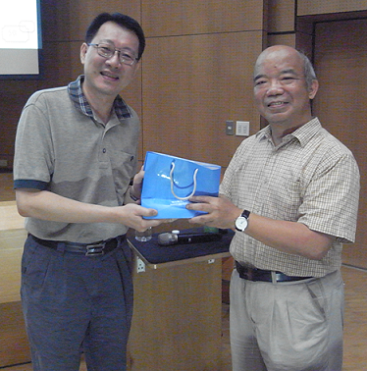 |
|
Professor Shoou-Jinn Chang (right) and GIPO chairman, Professor Gong-Ru Lin (left) |
|
|
October、November “GIPO Colloquium” Highlights
(Compiled by Li-Chi Yao) |
|
|
4:30 pm, Oct. 30 (Fri.), 2015 |
|
Speaker: |
Professor Jia-Ming Liu
(Electrical Engineering Department, UCLA) |
|
Topic: |
Terahertz Graphene Photonics and Plamsonics |
| |
Professor Jia-Ming Liu visited GIPO on Oct. 30 (Fri.) and delivered a speech concerning “Terahertz Graphene Photonics and Plamsonics” at auditorium 105, EE Building II. His speech was fascinating and the professor interacted well with students. GIPO teachers and students were happy to participate in this event, and learned a great deal. |
|
|
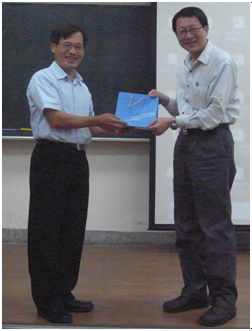 |
|
Professor Jia-Ming Liu (left) and GIPO chairman, Professor Gong-Ru Lin (right) |
|
|
|
4:30 pm, Nov. 6 (Fri.), 2015 |
|
Speaker: |
Professor Arthur Chiou
(Biophotonics and Molecular Imaging Research Center , National Yang-Ming University) |
|
Topic: |
How Optical Microrheology & Microscopy Quantify Biophysical Markers to Complement the Biochemical at Cellular and Sub-cellular Level? |
| |
Professor Arthur Chiou visited GIPO on Nov. 6 (Fri.) and delivered a speech concerning “How Optical Microrheology & Microscopy Quantify Biophysical Markers to Complement the Biochemical at Cellular and Sub-cellular Level?” at auditorium 101, Barry Lam Hall. His speech was excellent and the professor interacted very well with students. GIPO teachers and students participated with enthusiasm and learned a great deal. |
|
|
 |
|
Professor Arthur Chiou (right) and GIPO Professor Si-Chen Lee (left) |
|
|
|
2:30 pm, Nov. 16 (Mon.), 2015 |
|
Speaker: |
Professor David J. Hagan
(CREOL, UCF) |
|
Topic: |
Nonlinear refraction and absorption: Mechanisms, Characterization and Applications |
| |
Professor David J. Hagan visited GIPO, in answer to GIPO professor Jiun-Haw Lee’s invitation, on Nov. 16 (Mon.) and delivered a speech concerning “Nonlinear refraction and absorption: Mechanisms, Characterization and Applications” at auditorium 105, EE Building II. His speech was informative and the speaker interacted very well with students. GIPO teachers and students attended this event with enthusiasm and learned a great deal. |
|
|
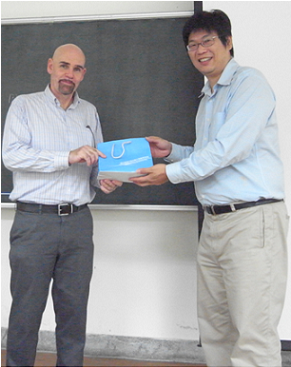 |
|
Professor David J. Hagan (left) and Professor Jiun-Haw Lee (right), the host of this speech |
|
|
|
4:30 pm, Nov. 20 (Fri.), 2015 |
|
Speaker: |
Professor Wood-Hi Cheng (visiting professor, Graduate Institute of Optoelectronic Engineering, National Chung Hsing University) |
|
Topic: |
The Art and Science of Packaging High-Coupling Photonics Devices |
| |
Professor Wood-Hi Cheng visited GIPO on Nov. 20 (Fri.) and delivered a speech concerning “The Art and Science of Packaging High-Coupling Photonics Devices” at auditorium 101, Barry Lam Hall. His speech was excellent, and the professor interacted well with his audience. GIPO teachers and students were happy to attend this event and learned a great deal. |
|
|
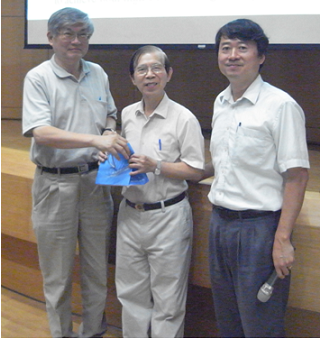 |
|
Professor Wood-Hi Cheng (middle), GIPO Professor Hung-Chun Chang (left), and Professor Sheng-Lung Huang (right), the host of this speech |
|
|
December “GIPO Colloquium” Highlights
(Compiled by Li-Chi Yao) |
|
|
4:30 pm, Dec. 4 (Fri.), 2015 |
|
Speaker: |
Professor Ursula J. Gibson
(Department of Physics, Norwegian University of Science and Technology) |
|
Topic: |
New materials for Solar Energy and Mid-infrared applications |
| |
Professor Ursula J. Gibson visited GIPO, in answer to GIPO professor Lon A. Wang’s invitation, on Dec. 4 (Fri.) and delivered a speech concerning “New materials for Solar Energy and Mid-infrared applications” at auditorium 101, Barry Lam Hall. Her speech was fascinating and the professor interacted well with students. GIPO teachers and students participated with enthusiasm and learned a great deal. |
|
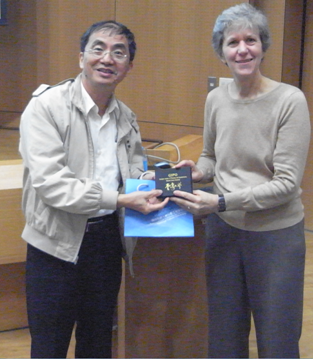 |
|
Professor Ursula J. Gibson (right) and Professor Lon A. Wang (left), the host of this speech |
|
|
|
4:30 pm, Dec. 18 (Fri.), 2015 |
|
Speaker: |
Professor Bing Sheu (emeritus chair professor, National Chiao Tung University) |
|
Topic: |
In digital era, the best role and strategy for one to play and integrate with information |
| |
Professor Bing Sheu visited GIPO on Dec. 18 (Fri.) and delivered a speech concerning “In digital era, the best role and strategy for one to play and integrate with information” at auditorium 101, Barry Lam Hall. His speech was interesting, and the speaker interacted very well with students. GIPO teachers and students participated with enthusiasm and benefited a great deal. |
|
 |
|
Professor Bing Sheu (right) and Professor Chih-I Wu (left), the host of this speech |
|
|
|
4:30 pm, Dec. 25 (Fri.), 2015 |
|
Speaker: |
Professor Yuan Luo
(Institute of Medical Device and Imaging, NTU) |
|
Topic: |
Spatial-spectral biomedical imaging |
| |
Professor Yuan Luo visited GIPO on Dec. 25 (Fri.) and delivered a speech concerning “Spatial-spectral biomedical imaging” at auditorium 101, Barry Lam Hall. His speech was fascinating and the professor interacted well with his audience. GIPO teachers and students were happy to attend this event and learned a great deal. |
|
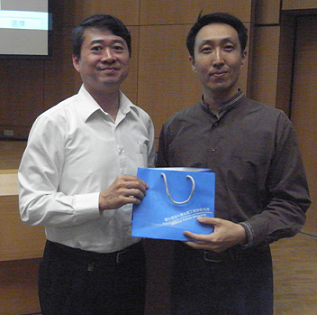 |
|
Professor Yuan Luo (right) and Professor Sheng-Lung Huang (left), the host of this speech |
|
|
 |
|
 |
|
| |
|
 |
|
~ 2015 Ph.D. Student Academic Exchange with Nanjing University ~
(The 8th Cross-Strait Ph.D. Student Forum on Photonic Science and Technology, 2015)
(Time:
Nov. 15-20, 2015;
Location:
Nanjing
University)
Composed by
Chia-Ying Su,
GIPO Ph.D. student
The Cross-Strait Ph.D. Student Forum on Photonic Science and Technology has entered its 8th year in 2015. This excellent long-term relationship can be attributed to hard work from both GIPO, NTU, and the School of Physics, NJU. It is a student-oriented activity, and each year, NTU and NJU take turns to sponsor it. Its purpose is to inspire, through workshops and cultural interactions, more comprehensive study inspirations and more opportunities for cooperation. Five out of the ten NTU students who are participating this year have already attended last year’s symposium, and I’m honored to be one of them and to be able to help in passing down this tradition. In addition to their own outstanding students, NJU has also invited students of other neighboring universities, including Nanjing Tech University, Southeast University, Nanjing University of Aeronautics and Astronautics, and Soochow University, to participate in this event. Therefore, there were 21 mainland students attending this symposium.
 |
|
A group photo of all attendants of the Ph.D. Student Forum |
In mid-November, our GIPO chairman, several professors and the doctoral students set out to Nanjing University, Jiangsu province, to begin this 6 days’ activity. It was already Sunday afternoon when we finally arrived at Nanjing Lukou International Airport. As soon as we entered the arrival hall, all we saw were smiling faces of NJU students’. Most of them were students who had visited Taiwan last year. The moment we saw these familiar faces once again after a whole year, laughter and greetings burst out all over the hall. Our friendship with NJU students developed from last year was not diminished by time. And, at this very moment, time seemed to have drawn us back to the scene of one year ago, in Taipei, so lovely, so familiar.
|
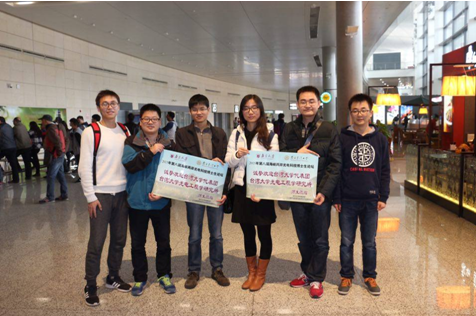 |
|
NJU students enthusiastically pick us up at the airport |
The academic discussion lasted for 2 whole days; the agenda was packed with fascinating topics. The symposium did not appear to be inferior to other international conferences. There were both universities professors’ lectures and students’ study reports covering the following 6 subjects: “solid state lighting and display”, “nonlinear optics”, “two-dimensional materials and devices”, “physics optics and laser technology”, “plasmonics and metamaterials”, and “photoelectric energy conversion, solar cell and battery”.
|
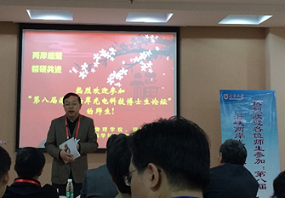 |
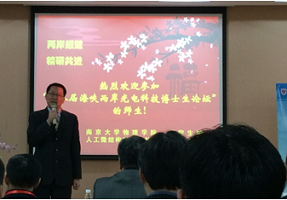 |
|
 |
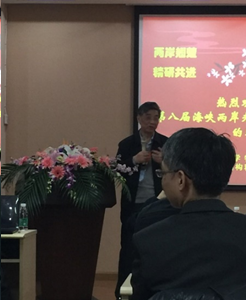 |
|
Professors addressed the opening ceremony |
Six professors gave us lectures on academic studies. Professor Jian-Jang Huang lectured on the study of “Enhancement-mode GaN on Si HEMTs”, which led to the production of high breakdown voltage device when a layer of pGaN was inserted under gate electrode. Professor Xing-Long Wu, NJU, lectured on the characters of oxygen creation and facet-cutting in the production of core/shell ZnO mesocrystal in terahertz frequency range with radiative emission and cubic In2O3 microparticles. He also lectured on the study of β-FeSi2 nanocubes, which produced very strong ferromagnetism even at room temperature. Professor Hoang-Yan Lin lectured on the study of a vision field calculation model displayed in 3D image. Professor Xiaoyong Wang, NJU, lectured on his study in a series of perovskite new materials. Professor Chao-Hsin Wu lectured on the exploration of achieving Giga-Hz spontaneous optical bandwidth by virtue of modulating base-collector voltage of light-emitting transistor. Professor Jia Zhu, NJU, showed us the way of using metal nanosphere to increase absorption and field strength, so as to enhance the solar energy transform efficiency to 90%.
|
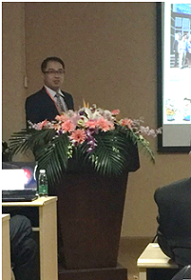 |
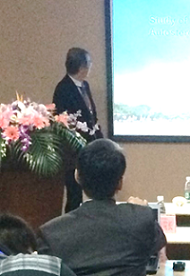 |
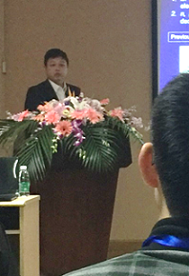 |
|
A snapshot of professors lecturing |
In the students’ study reports, each student had to report on his or her study and answer questions in 15 minutes. Besides answering other students’ questions, reporting students would also receive suggestions and advice from Professor Tao Yu, NJU, and Professor Jia Zhu, NJU. In the reporting, through academic exchange, students could realize the most advanced research of different fields, and could also gain valuable knowledge from related fields, which would of course benefit their future researches. I had noticed some differences between Taiwan and Mainland students. Generally speaking, Mainland students spoke faster, more smoothly, with full confidence, and used lots of references; therefore, I had to pay close attention to follow their reports. Taiwan students, on the other hand, paid more attention to interactions with the audience. While reporting, they observed the audience from time to time, detected audiences’ spontaneous reactions, and thereby modulated their tempo. The result was that all attendants of the report felt quite comfortable and at ease.
|
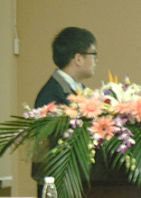 |
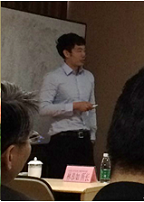 |
|
A snapshot of NTU students reporting |
During lunchtime at the symposium, the NJU students gave up their breaks to take us around their large campus for some sightseeing. Because of its high latitude, Nanjing was of the most beautiful during those early winter days. Rolls of yellow-leaved gingko trees stood along both sides of the trail. Lots of yellow leaves fell on the ground forming a beautiful blanket. Some leaves were just turning from green into brown, and their motley colors beautified the whole campus. We visited some historical buildings, such as Beidalo, a landmark building built in 1919, the small auditorium, and the library. We also took a group photo in front of NJU south gate.
|
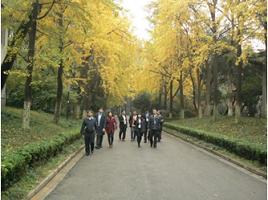 |
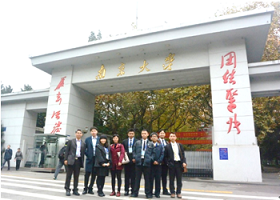 |
|
A view of NJU campus scenery |
At the end of the symposium, students from both sides exchanged presents, and voted for the 2 best theses and 2 best personality students from each side. Among Mainland students, Xiao-Chen Sun and Liangliang Sun were chosen the best thesis students. It’s the
second time Xiao-Chen won the best thesis; he won for the
first time last year. His distinct speech and steady style impressed me greatly. And, Liangliang’s poised manners and systematic reporting style has become our goal to learn. The Mainland’s 2 best personality winners were Chong Sheng, the well-known captain of the Mainland team, and Jin-Hui Chen. It’s the
second
time that Chong Sheng participated in this symposium. After forming good friendships from last year, he further took on the captain’s responsibility to take care of everything. Jin-Hui looked after the Taiwan students thoroughly, leading us on the tour of the NJU campus, sending us to the conference room and back to the hotel and ensuring that we would return to the hotel in time every night. Among the Taiwan students, Tsung-Chin Cheng won the best thesis prize because his report was considered very comprehensive. Li-Jen Hsiao, the captain of the Taiwan team, won the best personality prize because he took on the laborious responsibility to take care of the whole team. I would like to thank the Mainland students’ for their kindness in conferring both the best thesis and the best personality prizes upon me. It was such a great honor! I was grateful and also under pressure, being the first student to report on stage. Nevertheless, the pressure inspired me to maximize my potential. And, I would like to thank my instructing professor for his assistance and effective training during the process, which made it possible for me to win this prize. Furthermore, I was the only girl on Taiwan team; perhaps that made me stand out during the activities at the symposium. Perhaps that is the real reason that I won the best personality prize.
|
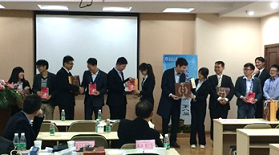 |
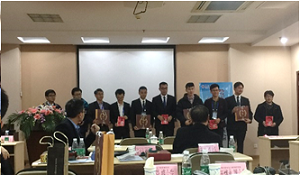 |
|
Students from both sides exchanging gifts |
|
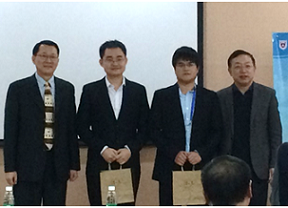 |
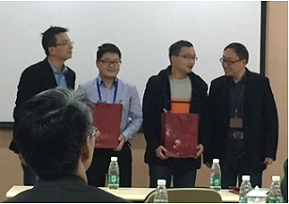 |
|
A snapshot of the awarding ceremony, (left) NJU best thesis winners – Xiao-Chen Sun & Liangliang Sun, and (right) NJU best personality winners – Chong Sheng & Jin-Hui Chen |
|
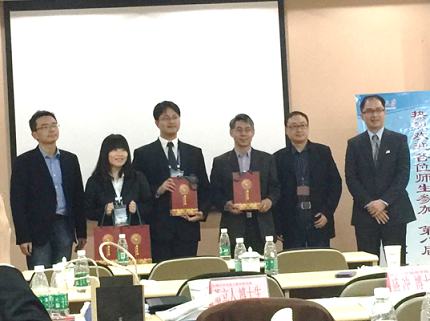 |
|
A snapshot of the awarding ceremony, NTU winners – Chia-Ying Su, Li-Jen Hsiao & Tsung-Chin Cheng |
Finally, we would like to thank GIPO office for providing this rare opportunity for students from both sides to meet and exchange ideas, appreciate each other’s culture and establish friendship. Although it lasted for 6 days only, I do believe that the wonderful memories and the academic value it created is worth far more than the 6 days we spent. Therefore, I would suggest that GIPO junior students strive for the opportunities to join this symposium, so as to improve yourselves, increase your knowledge and enhance your personal connections.
|
|
 |
|
 |
|
| |
|
 |
Plasmon-enhanced Photoluminescence of an Amorphous Silicon Quantum Dot Light-Emitting Device by Localized Surface Plasmon Polaritons in Ag/SiOx:a-Si QDs/Ag Sandwich Nanostructures
Professor Hoang-Yan Lin
Graduate Institute of Photonics and
Optoelectronics, National Taiwan
University
We investigated experimentally the plasmon-enhanced
photoluminescence of the amorphous silicon quantum dots (a-Si QDs)
light-emitting devices (LEDs) with the Ag/SiOx:a-Si QDs/Ag sandwich
nanostructures (Fig. 1), through the coupling between the a-Si QDs and localized
surface plasmons polaritons (LSPPs) mode, by tuning a one-dimensional (1D) Ag
grating on the top. The coupling of surface plasmons at the top and bottom
Ag/SiOx:a-Si QDs interfaces, resulting in the localized surface
plasmon polaritons (LSPPs) confined underneath the Ag lines, which exhibit the
Fabry–Pérot resonance. From the Raman spectrum, it proves that the existence of
a-Si QDs embedded in Si-rich SiOx film (SiOx:a-Si QDs) at
a low annealing temperature (300℃) to prevent the possible diffusion of Ag atoms
from Ag film. The photoluminescence (PL) spectra of a-Si QDs can be precisely
tuned by a 1D Ag grating with different pitches and Ag line widths (Fig. 2) were
investigated. An optimized Ag grating structure, with 500 nm pitch and 125 nm Ag
line width, was found to achieve up to 4.8-fold PL enhancement at 526 nm and
2.46-fold PL integrated intensity compared to the a-Si QDs LEDs without Ag
grating structure, due to the strong a-Si QDs–LSPPs coupling (Fig. 3).
(International Journal of Photoenergy (Volume 2015 (2015), Article ID 140617)
|

|
|
Fig. 1. Schematic view of a-Si QDs LEDs with
a Ag/SiOx:a-Si QDs/Ag sandwich
nanostructures |
|
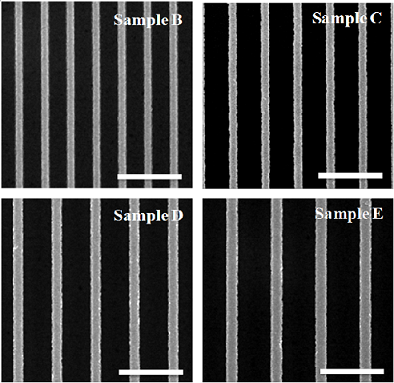
|
|
Fig. 2. SEM images of a series of Ag
gratings (samples B-E). Scale bar is 1 μm |
|
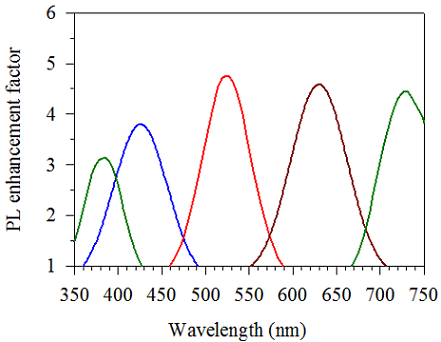
|
|
Fig. 3. The plots of the PL enhancement
factor of samples B-E |
Direct QAM-OFDM Encoding of a Master-to-Slave Injection-Locked WRC-FPLD Pair for 28×20 Gbit/s DWDM-PON Transmission
Professor Gong-Ru
Lin’s laboratory
Graduate Institute of Photonics and
Optoelectronics, National Taiwan
University
This work demonstrated a master-to-slave
injection-locked weak-resonant-cavity Fabry-Perot laser diode (WRC-FPLD) pair,
which is capable of carrying an orthogonal frequency division multiplexed
16-quadrature amplitude modulation (16-QAM OFDM) data at 20 Gbit/s/channel for
28 channels in a dense wavelength division multiplexing passive optical network
(DWDM-PON), as illustrated in Fig. 1. Since the lower front-facet reflectance
and longer cavity features of WRC-FPLD, it reveals broader gain spectrum with
denser longitudinal modes and higher injection efficiency than a typical FPLD
for supporting more DWDM channels. As a result, the optical spectra of master
and slave WRC-FPLDs are shown in Fig. 2. After passing through a demultiplexer
with a channel spacing of 50 GHz for the central mode of master WRC-FPLD, the
filtered single-mode master with a peak power of -4 dBm was employed to
injection-lock the slave WRC-FPLD, which achieves a side-mode suppression ratio
(SMSR) of 50 dB. Moreover, the bit error rate (BER) performances of back-to-back
and 25-km single-mode fiber (SMF) transmitted 20-Gbit/s OFDM data carried by the
master-to-slave injection-locked WRC-FPLD pair at different channels are shown
in Fig. 3. For the central mode injection case, the back-to-back transmitted BER
of 1.6×10-5 can be improved to 2.9×10-7 by employing the
OFDM subcarrier per-leveling technique, and it is inevitably degraded to 2.1×10-4
due to the fiber dispersion after 25-km SMF transmission. To meet the forward
error correction (FEC) the required BER of 3.8×10-3, 28 DWDM channels
can be obtained to reveal a total data-rate of 28×20=560 Gbit/s. Therein, a
slightly decreased SMSR of 35 dB is also obtained for the farthest side-mode
injection case. In conclusion, the master-to-slave injection-locked WRC-FPLD
pair has shown its competitive performance and superior flexibility to fit
multi-channel DWDM-PON transmission.
|

|
|
Fig. 1. The schematic diagram of the master-to-slave injection-locked WRC-FPLD pair based DWDM-PON system for direct 16-QAM OFDM modulation and transmission. |
|

|
|
Fig. 2. The optical spectra of master and slave WRC-FPLDs. |
|
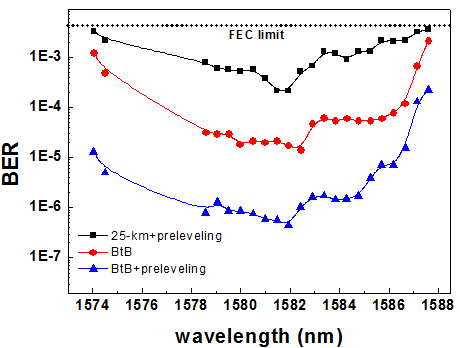
|
|
Fig. 3. The BER performances of back-to-back and 25-km SMF transmitted 28-Gbit/s 16-QAM OFDM data. |
Enhancing Light Out-Coupling of Organic Light-Emitting Devices with Nanostructured Composite Electrodes
Professor Chung-Chih Wu
Graduate Institute of Photonics and
Optoelectronics, National Taiwan
University
Due to their various merits, organic
light-emitting devices (OLEDs) have posed as promising candidates for the
next-generation display and lighting technologies. All these applications have
been imposing increasing efficiency requirements on OLEDs. While internal
quantum efficiencies close to 100% have been reported with phosphorescent or
other triplet-harvesting OLEDs, typical OLEDs suffer from a poor extraction
efficiency of internally generated photons, resulting from a large mismatch of
the refractive indices between organic layers, indium tin oxide, glass, and air.
The total internal reflection at the interfaces of devices strongly traps
photons inside the device, which significantly limits the external quantum
efficiency (EQE) of OLEDs. It is known that ~70-80% of the generated photons are
trapped in conventional OLED structures due to total internal reflection or
coupling to surface plasmon polaritons (SPPs) at the metallic surface. In our
studies, we have developed a novel internal extraction structure using a
nanostructured composite transparent electrode (Figure 1), which not only
functions as the current conductor/injector for the device but also
significantly enhances out-coupling of OLED internal radiation. With such a
technique, we have realized a very high externalquantum efficiency of 62% and a
very high luminous efficiency of 264 lm/W in OLEDs (Figure 1).
|

|
|
Figure 1. Achieving very high external
quantum and power efficiencies of OLEDs with
nanostructured composite electrodes |
Flexible Transparent Graphene-based Composite Transparent Electrode Prepared with Copper Vapor Assisted CVD and Innovative Polymer-free Transfer Method
Professor Chih-I Wu
Graduate Institute of Photonics and
Optoelectronics, National Taiwan
University
The major tasks of this
research project is to fabricate flexible or
transparent perovskite halogenide solar cells by
whole solution processes for high enough energy
conversion efficiency at low sun luminance
condition. The initial achievements of whole
solution processes and optoelectronic
characterization include one-step precursor
deposition, solvent induced fast
crystallization, vapor assisted solution process.
Each of these processing technologies resulted
in the analyses comparing their I-V curves, fill factor, open-circuit voltage, optoelectronic
energy conversion efficiency. These measurements
were done for different fil thickness, since the
correlation between characterizations and
thickness is important to evaluate the
flexibility and transparency of perovskite solar
cells.
Transparent graphene electrode materials have been improved by
innovative copper vapor assisted
C. V. D. for graphene/Cu
composite thin film synthesis.
Such grown composite electrode
were transferred by special
"Protective Frame Transfer
Method" to form double layered
composite electrode material
that held transmittance 94.4%
and low electric sheet
resistance as 0.1 k ohm/sqare.
2D-band to G-band peak ratio of
1.8 measured by Raman
spectroscopy, and X-ray
Photoelectron Spectroscopy
(X.P.S.) showed minor existence
of copper on graphene, such
evidence of Cu on graphene
surface was supported with
photograph taken using scanning
electron microscopy. Those peak
positions of 2D-band and G-band
were found shifted to higher
Raman Shift (1/cm) side. These
phenomena imply that C-C bonding
strength of graphene intra-plane
and inter-layer van der Waal
bonding could be enhanced at
those portions where copper
particles/islands are bonded to
graphene. Comparing graphene/Cu
composite and that etched off
copper with nitric acid
solution, their density of
states analyses for valence band
using Ultraviolet Photoelectron
Spectroscopy showed that
semi-metallic graphene’s valence
band structure had no
significant rising 1~2 eV near
Fermi Level for this composite
thin film. Thus, the enhanced
electric conductivity could
majorly be attributed to the
bridging effect of lower
resistant copper
particles/islands across high
resistant domain boundaries of
graphene leading to increased
electric current paths through
low electric sheet resistance.
Resulted in much higher
successful film transfer ratio,
this bridging effect had been
supported by enhanced mechanical
strength effect of graphene/Cu
composite films than pure
graphene films.
|

|
|
Fig. 1. SEM photographs: (a) Near; (b)
farther from, (c) near, uniform temperature
zone |
|

|
|
Fig. 2. Raman spectroscopic plots |
|

|
|
Fig. 3. X-ray Photoelectron Spectroscopic
plots showing work function increase with
graphene/copper composites |
|
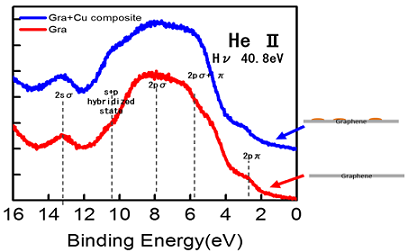
|
|
Fig. 4. Ultraviolet Photoelectron
Spectroscopic plots showing no density of
states increase near Fermi Level with
graphene/copper composites |
A Circular-Ring Miniaturized-Element Metasurface With Many Good Features for Frequency Selective Shielding Applications
Professor Yih-Peng Chiou's laboratory
Graduate Institute of Photonics and
Optoelectronics, National Taiwan
University
A novel circular-ring
miniaturized-element (CRME) metasurface is proposed for frequency selective
electromagnetic shielding applications in this paper. The proposed structure
exhibits good performance in many aspects. The CRME size can be easily reduced
to 0.088 rx0.088 rx0.088 r,
where r,
where
 r
is the wavelength at resonance. Such small size can be useful in applications
with limited space. The newly proposed metasurface not only shows the stability
to incidence angles and polarizations, but also demonstrate negligible
polarization crossing. The metasurface also presents low coupling between
elements, which leads to the insensitivity of periodicity fluctuation in
fabrication process. Moreover, the frequency responses can be varied through the modification of the element pattern of the metasurface. It provides flexible
frequency responses to use in frequency selective shielding applications. Also,
this element is suitable for constructing a metasurface aligned in either square
or even hexagonal lattice, which owns the best adaptability to a doubly curved
surface or a spherical one. Without revising the CRME, both the squareand
hexagonal-lattice metasurfaces constructed can perform competently at the same
time. Finally, the metasurface prototype is fabricated and tested in a fully
anechoic chamber to verify the design. The measured results well agree with the
simulated ones. This work is published in IEEE Transaction on Electromagnetic
Compatibility, June 2015. r
is the wavelength at resonance. Such small size can be useful in applications
with limited space. The newly proposed metasurface not only shows the stability
to incidence angles and polarizations, but also demonstrate negligible
polarization crossing. The metasurface also presents low coupling between
elements, which leads to the insensitivity of periodicity fluctuation in
fabrication process. Moreover, the frequency responses can be varied through the modification of the element pattern of the metasurface. It provides flexible
frequency responses to use in frequency selective shielding applications. Also,
this element is suitable for constructing a metasurface aligned in either square
or even hexagonal lattice, which owns the best adaptability to a doubly curved
surface or a spherical one. Without revising the CRME, both the squareand
hexagonal-lattice metasurfaces constructed can perform competently at the same
time. Finally, the metasurface prototype is fabricated and tested in a fully
anechoic chamber to verify the design. The measured results well agree with the
simulated ones. This work is published in IEEE Transaction on Electromagnetic
Compatibility, June 2015.
|
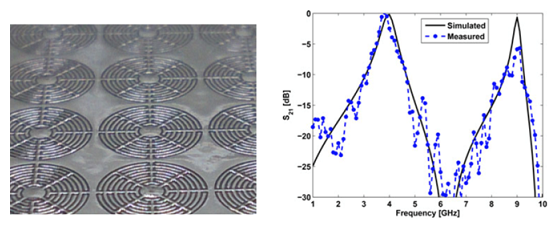
|
|
Left: The fabricated prototype of the eight-turn CRME metasurface with the line width of 0.15 mm and Λ = 6.7 mm. Right: Eight-turn CRME metasurface at normal incidence. Simulated and measured results are very consistent. |
Improvement of color stability in white organic light-emitting diode by phosphor dopant
Professor Jiun-Haw Lee
Graduate Institute of Photonics and
Optoelectronics, National Taiwan
University
With the incorporation of
thin (4 nm) and lightly doped (1%) phosphor,
tris(phenylpyridine)iridium (Ir(ppy)3),
inside the emitting layer close to the electron
transporting layer interface of an organic
light-emitting diode (OLED), electron injection
characteristic was improved. Together with the
recombination zone shift under different voltage
driving, a white OLED with stable
electroluminescence (color coordinate shift
(0.012, 0.002) from 100 to 10000 cd/m2)
was demonstrated.
|
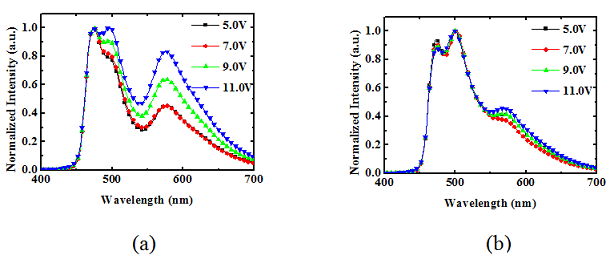 |
|
Fig. 1. Electroluminescence spectra of OLED
(a) without and (b) with interface phosphor
dopant |
|
|
|
 |
|
 |
|
| |
|
|
 |
|
 |
|
|
|